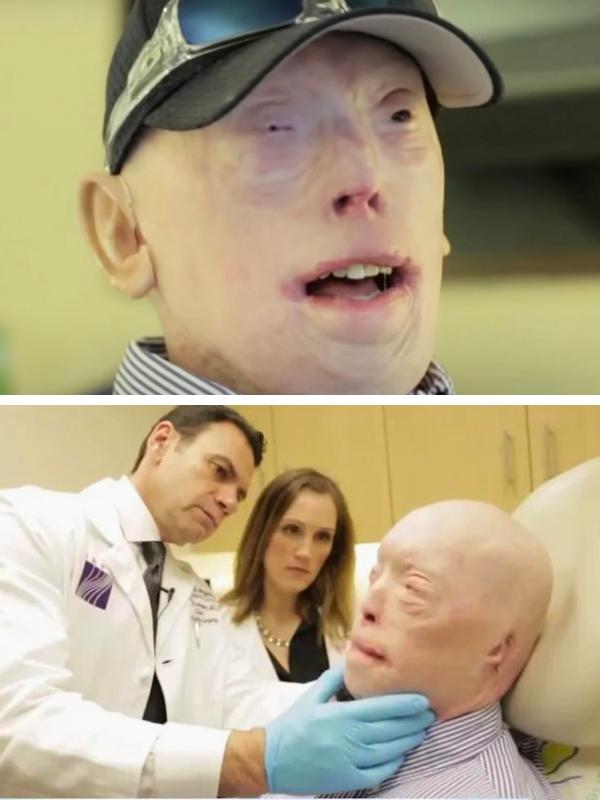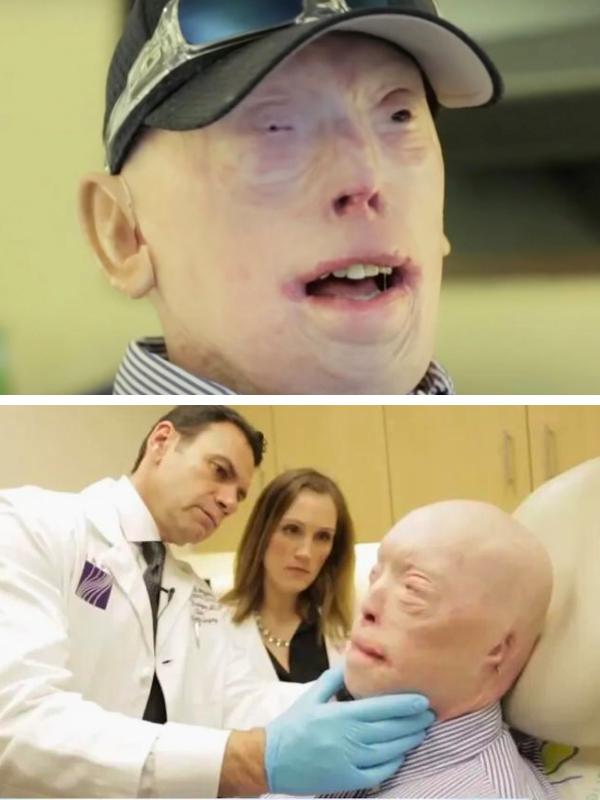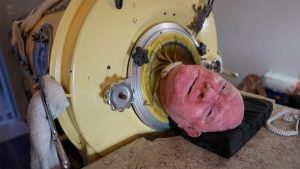
In a breakthrough medical achievement, 41-year-old Patrick Hardison, a volunteer firefighter who suffered severe burns in a 2001 blaze, has received the most extensive face transplant ever performed. This life-changing procedure, which took place in August 2015 at NYU Langone Medical Center in New York, has brought him closer to regaining his normal vision and a semblance of the life he once knew.a
For Hardison, whose face and scalp were severely burned in the line of duty, the surgery represents more than just aesthetic restoration. It marks a new chapter in his life—one where he can once again look at himself in the mirror and see the face he once had, and perhaps most importantly, regain the ability to see the world around him.
A Hero’s Sacrifice

Patrick Hardison’s journey to this groundbreaking surgery began nearly 15 years ago when, as a 27-year-old volunteer firefighter, he suffered third-degree burns while responding to a house fire in Senatobia, Mississippi. Hardison had rushed into a burning building to rescue a woman, but the roof collapsed while he was inside. He sustained severe burns on his head, neck, and upper torso.
Despite his heroic actions, Hardison was left with devastating physical damage. His ears, lips, most of his nose, and virtually all of his eyelid tissue were lost, leaving him unable to blink properly. He endured over 71 surgeries and lived with pinhole vision, struggling to see the world clearly.
“I was almost totally blind,” Hardison recalled. “I could see just a little bit.”
Though his appearance had drastically changed, Hardison didn’t let his physical transformation define him. He continued to participate in life, attending baseball games and staying active, even if it meant facing the harsh reality of people staring at him. He would joke with children, telling them that he had fought a bear, but behind the humor was the pain of living with the consequences of his injuries.
The Road to a New Face

After years of enduring painful surgeries and limited vision, Hardison received the opportunity to pursue a face transplant. This was a chance not only to restore his appearance but also to regain his sight and functionality.
Hardison’s face transplant surgery, led by Dr. Eduardo Rodriguez, took place on August 14, 2015. The procedure lasted an impressive 26 hours, with a surgical team carefully transferring four bone segments and significant facial tissue from the donor. This extensive transplant covered his skull and much of his neck, including his eyelids, ears, and scalp.
The transplant was made possible through a donor—26-year-old David P. Rodebaugh, a competitive cyclist and artist who tragically died following a biking accident. Rodebaugh had expressed his desire to donate his organs and tissues upon his passing, and his family honored his wishes by donating his face, knowing it would be used to help someone in need. This selfless act provided Hardison with the chance to not only restore his appearance but also regain normal vision for the first time in over a decade.
Dr. Rodriguez, who had previously performed a face transplant at the University of Maryland Medical Center in 2012, noted that this procedure was the most extensive face transplant ever conducted. The transplant included not only the facial features but also a large portion of Hardison’s scalp, which was carefully matched to his dark blond hair, allowing for a more natural appearance.
Recovery and Transformation
:max_bytes(150000):strip_icc():focal(813x0:815x2)/patrick-hardison-1-2000x2000a-e1d9564062f9462c85813d2a55258f5d.jpg)
Hardison’s recovery process is still ongoing, but the results of the transplant have already been life-changing. He is now able to see much more clearly thanks to the restoration of his eyelids, and his physical therapy has helped him adjust to his new appearance. In a recent interview, he shared his excitement about regaining his ability to drive, a major milestone that he had not been able to achieve for over a decade due to his limited vision.
While the lower part of his face remains swollen, doctors are optimistic that this will subside in the coming months, leaving him with a natural, integrated appearance. Dr. Rodriguez emphasized that over time, Hardison’s face will blend the features of both his original face and the donor’s, making it more difficult for a casual observer to notice anything unusual.
“It’s a historic achievement,” said Dr. Amir Dorafshar, co-director of the Face Transplant Program at the Johns Hopkins University School of Medicine, who was not involved in the surgery. “This type of treatment option will potentially revolutionize the care of patients with severe facial injuries.”
A New Beginning and a New Purpose
Three months post-surgery, Hardison is already seeing the difference in how others perceive him. He remarked that for the first time in years, when he goes out, people no longer stare—he is now seen as just another person in the crowd. This transformation has not only restored his appearance but has also helped him regain his confidence.
Although Hardison’s days as a firefighter are over due to insurance and safety concerns, he is determined to use his experience to help others. He is considering a new career path as a motivational speaker, aiming to inspire others, especially wounded veterans, with his story of resilience and hope.
“I want to show people that there is hope,” Hardison shared. “There is always a way to move forward, no matter how tough life gets.”
The Impact of Face Transplants on Future Treatment
Patrick Hardison’s story serves as a beacon of hope for those with severe facial injuries. His successful face transplant is not just a milestone for medical science but also a testament to the power of donation and the selflessness of people like David P. Rodebaugh, whose gift has given Hardison a new chance at life.
While face transplants are still rare and complex, the advances in surgical techniques and post-transplant care offer a brighter future for those in need of similar procedures. As the field of face transplantation continues to evolve, Hardison’s case provides a powerful example of what is possible with innovation, dedication, and compassion.


